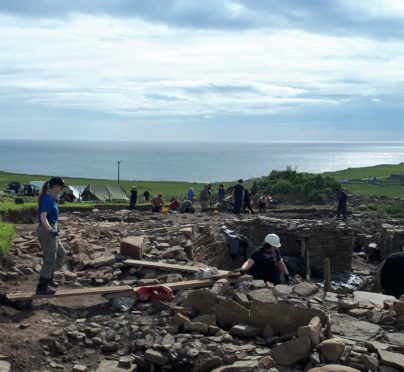Analysis of a midden has uncovered evidence of a great open air feast taking place at an archaeological site in Orkney 2,000 years ago.
The Cairns dig is situated on a wild and wind-swept cliff above Windwick Bay in South Ronaldsay.
It a research and training excavation for the University of the Highlands and Islands Archaeology Institute and has provided many insights into ordinary life in Iron Age Orkney.
Dates have become available this week which have been obtained from measuring the amount of carbon in some of the dead animals found in the midden.
The information gives archaeologists a glimpse into a new episode in the life of this site nearly two thousand years ago, in what is known as the Middle to Late Iron Age.
The Cairns is known for the remains of an Iron Age broch, but also increasingly for a post broch metal working area in which a collection of 60 metal working moulds, remains of furnaces, crucibles and further evidence of considerable metal working were unearthed in 2017 . This included high status jewellery objects such as bronze pins and brooches. A huge midden of animal bones and broken pots lies adjacent and partly covers this metal working area.
Radiocarbon analysis of the midden suggests that it was created in the AD240s to AD 300s and further investigation of the deposits points to a great feast event being held on the spot at a time after the broch fell into disuse. This was a time of great social change in northern Scotland and was contemporary to the mid and late Roman period further south.
Martin Carruthers, site director and programme leader for MSc Archaeological Practice at the UHI Archaeology Institute, said: “We may be looking at how the social structure of an evolving Iron Age society worked. Using jewellery-making and sharing at a large social event as a mechanism to unite a community and define a social hierarchy. This whole assemblage gives us an intriguing insight into the possible social structure of Middle to Late Iron Age society in northern Scotland.”
He goes on to propose that, in the absence of brochs, open air feasting could have been a method in which evolving Iron Age society expressed “identity and solidarity”.
A large rectangular building is also present at the site, partly covering the remains of the broch. This imposing building was also present in the same period as the feasting event and perhaps represents the residence of a powerful household who organised the production and distribution of the valuable jewellery pieces.










